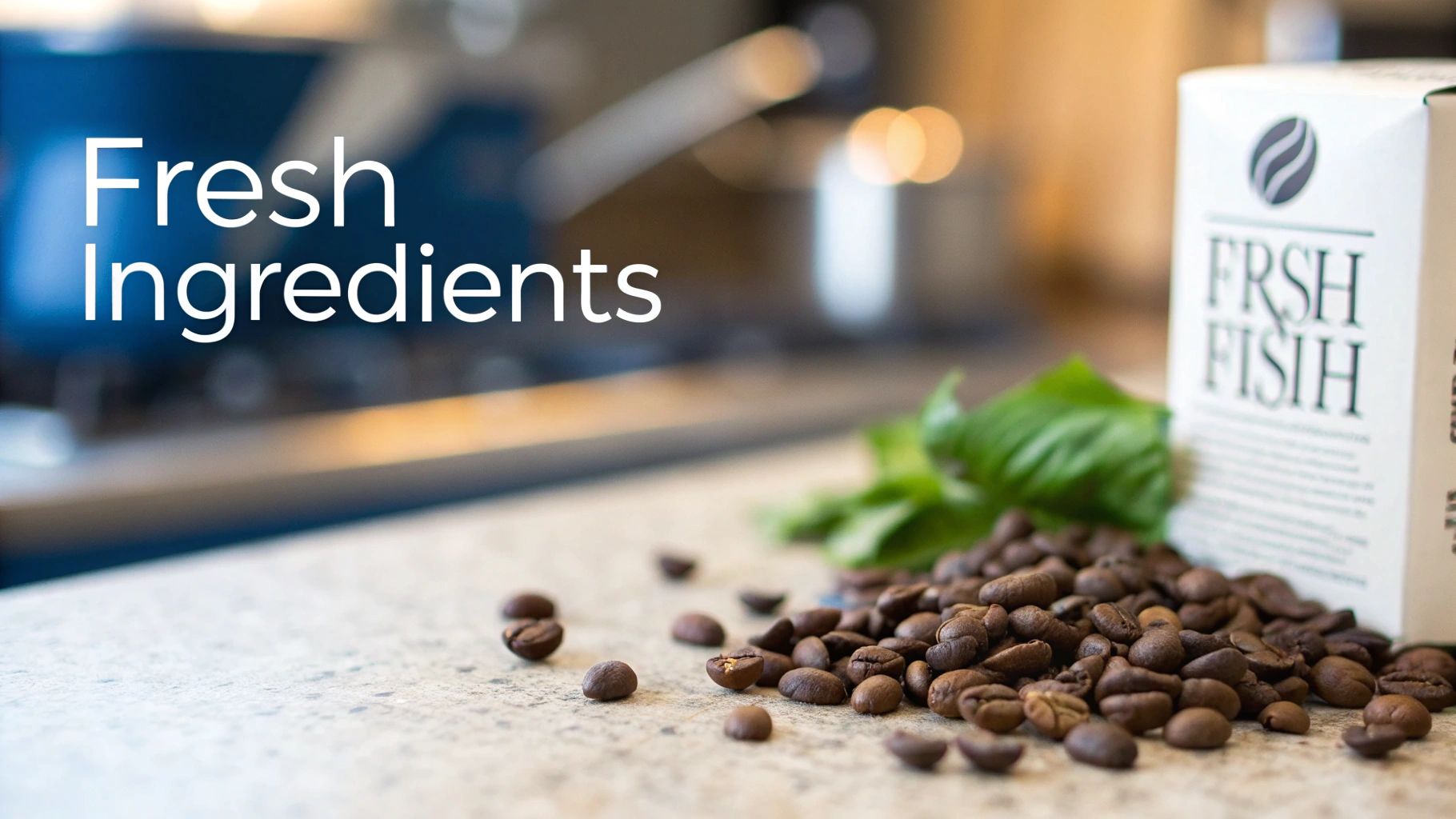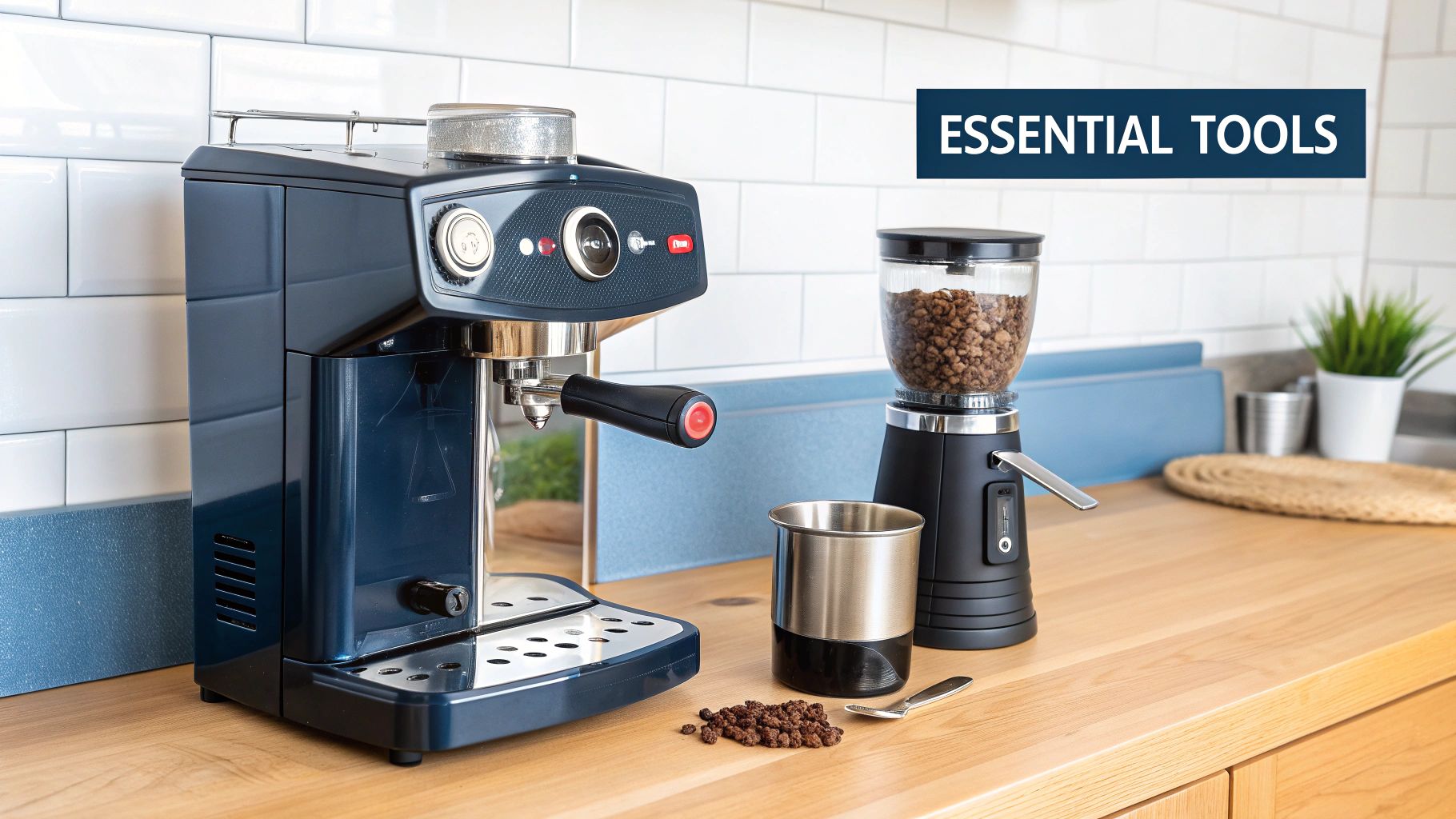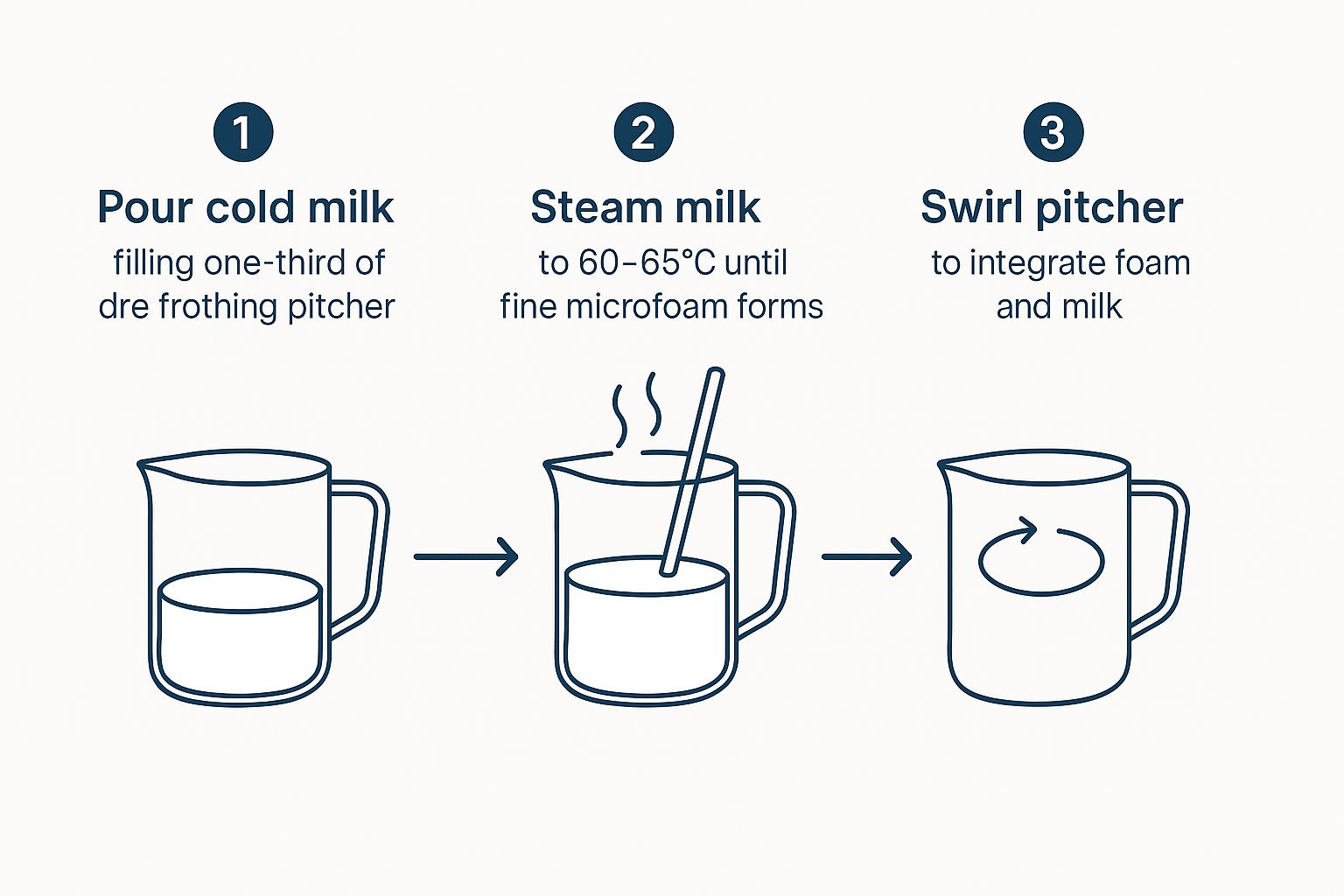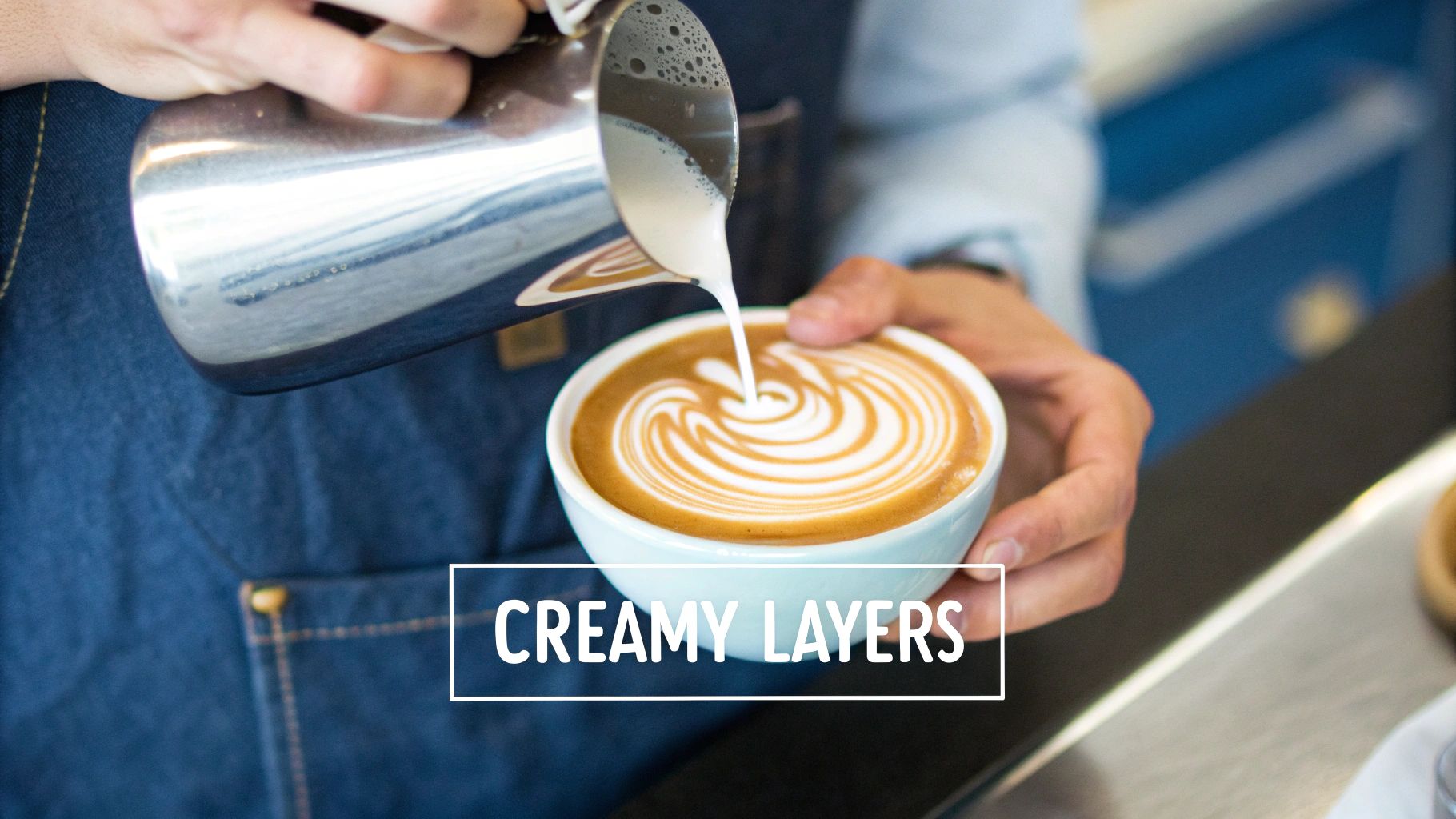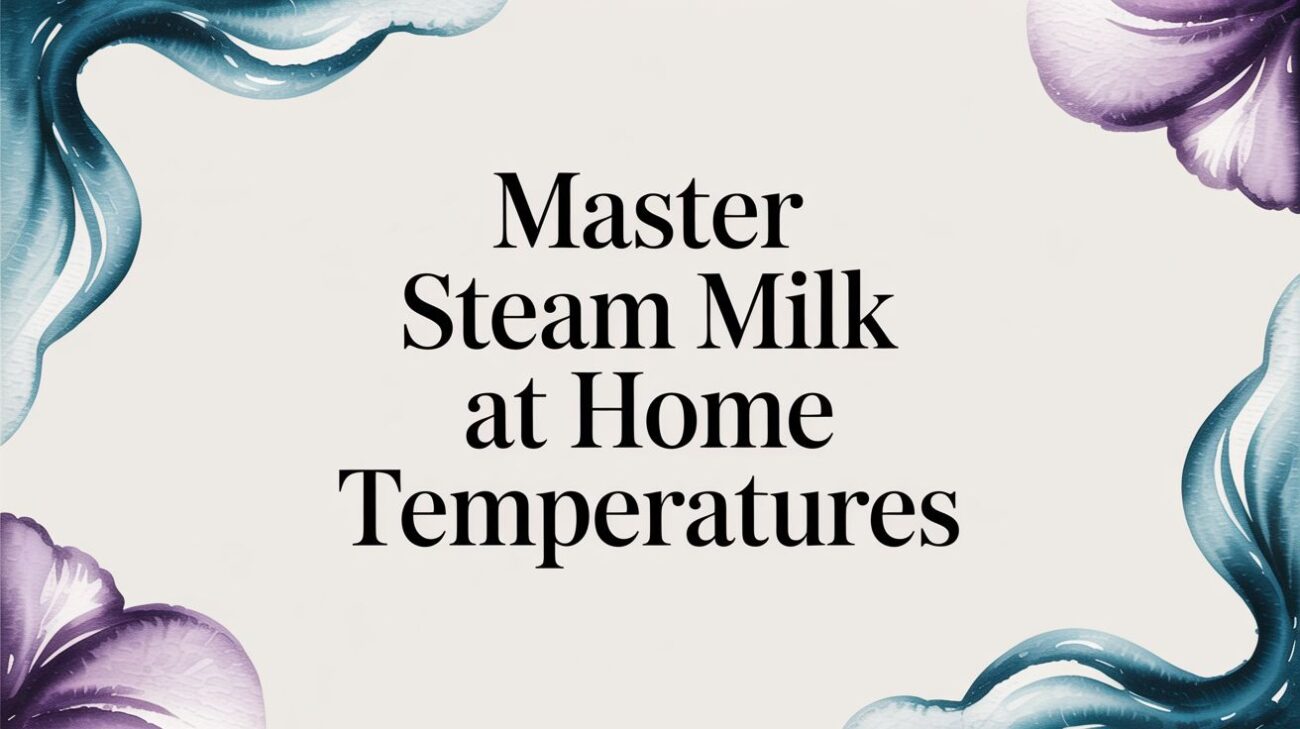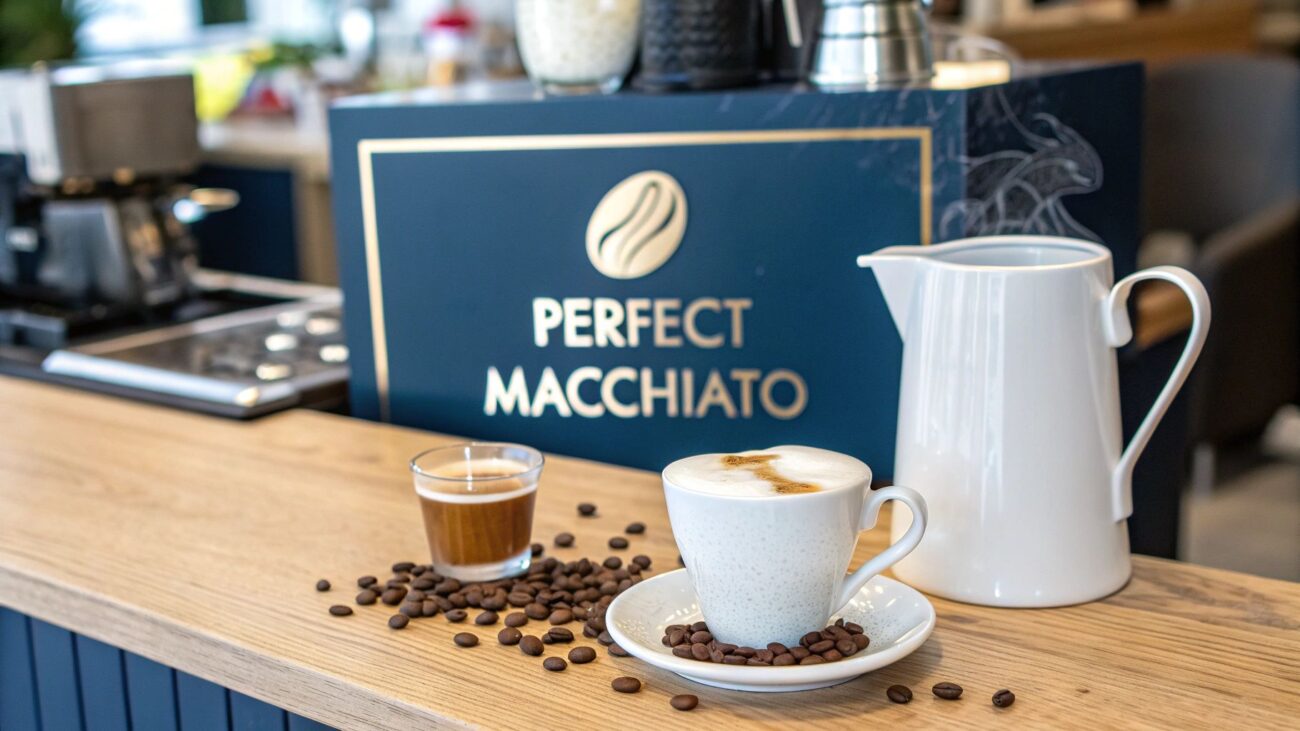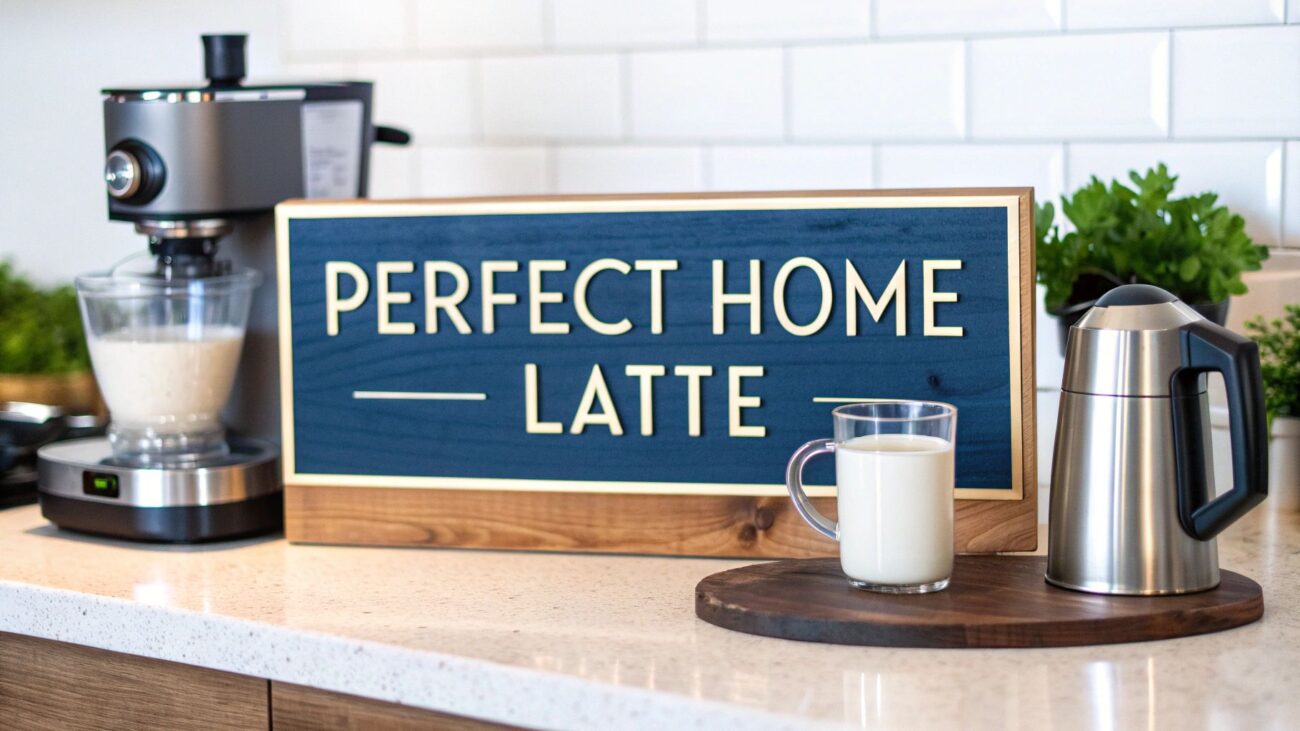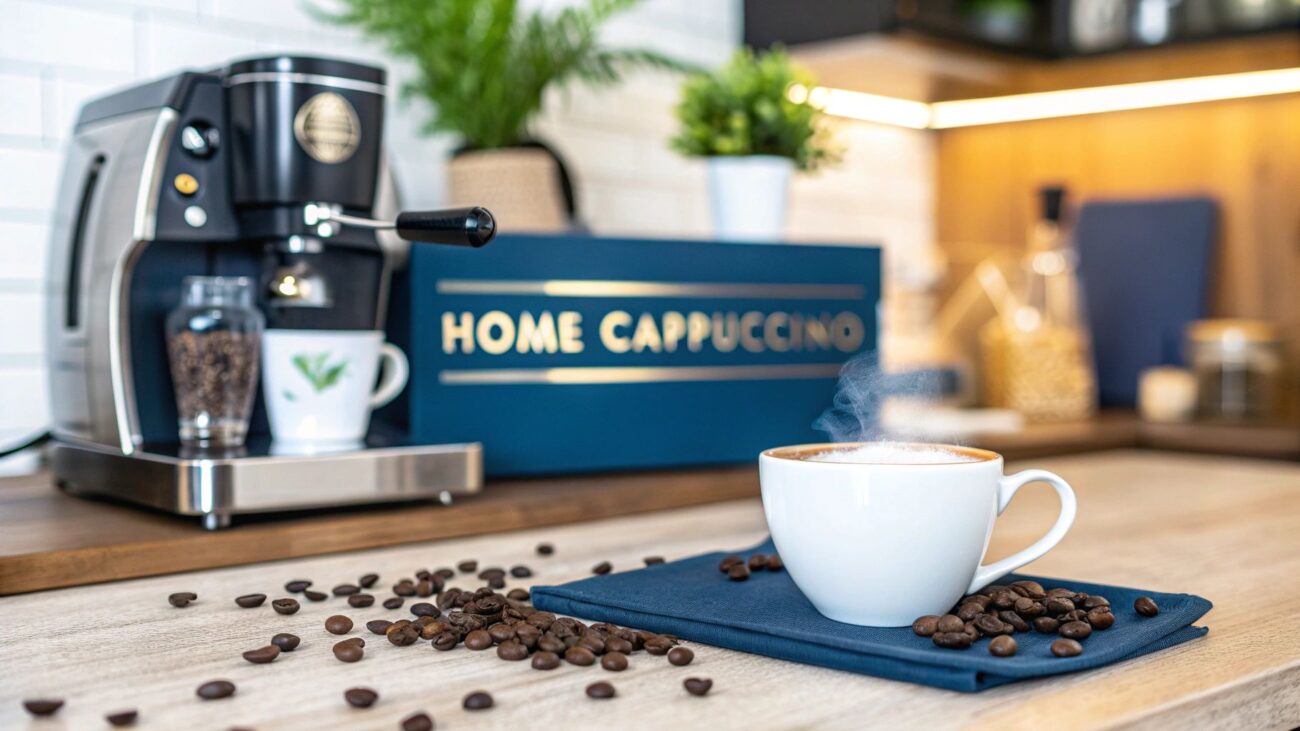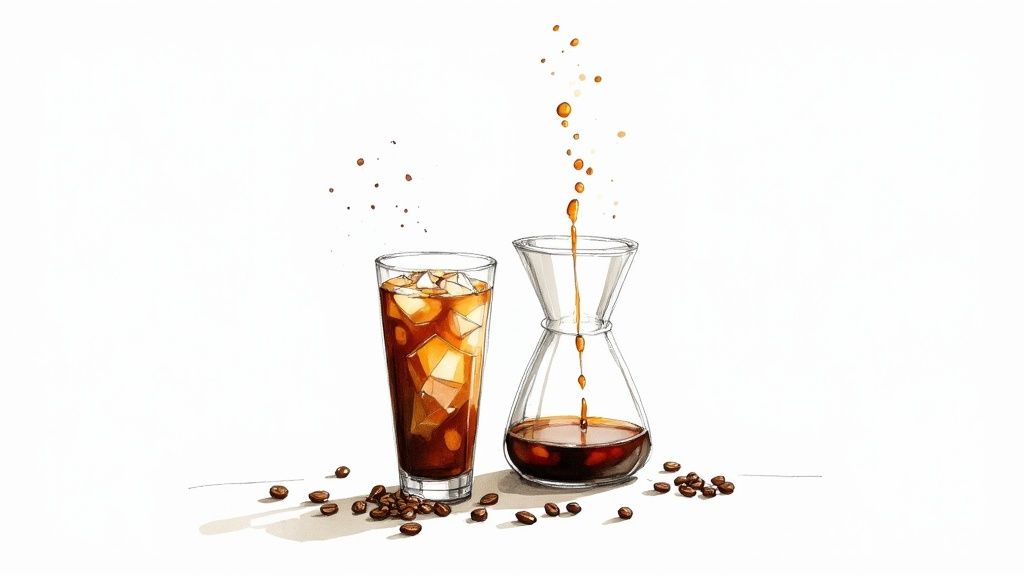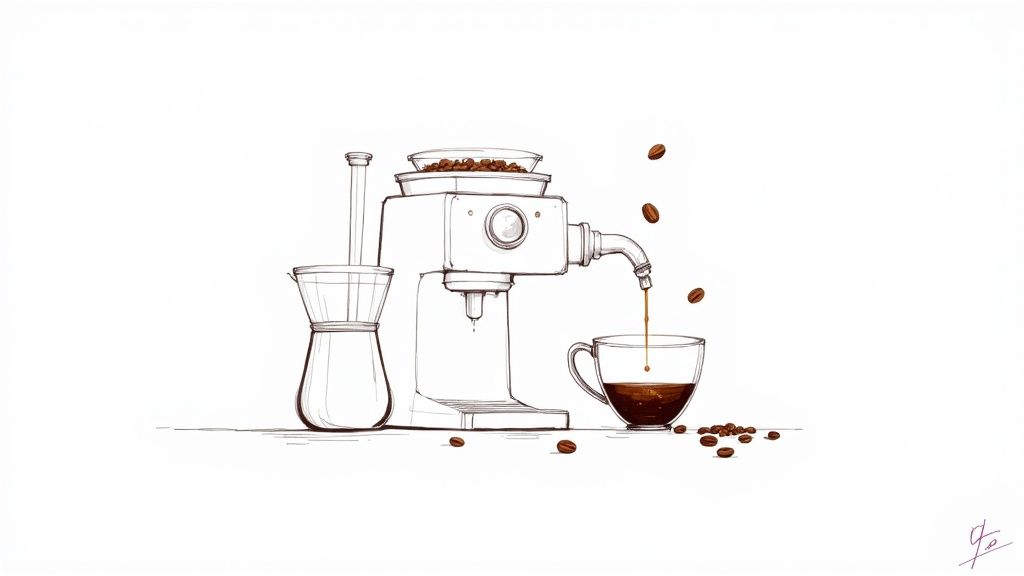How to Make a Latte at Home Like a Pro
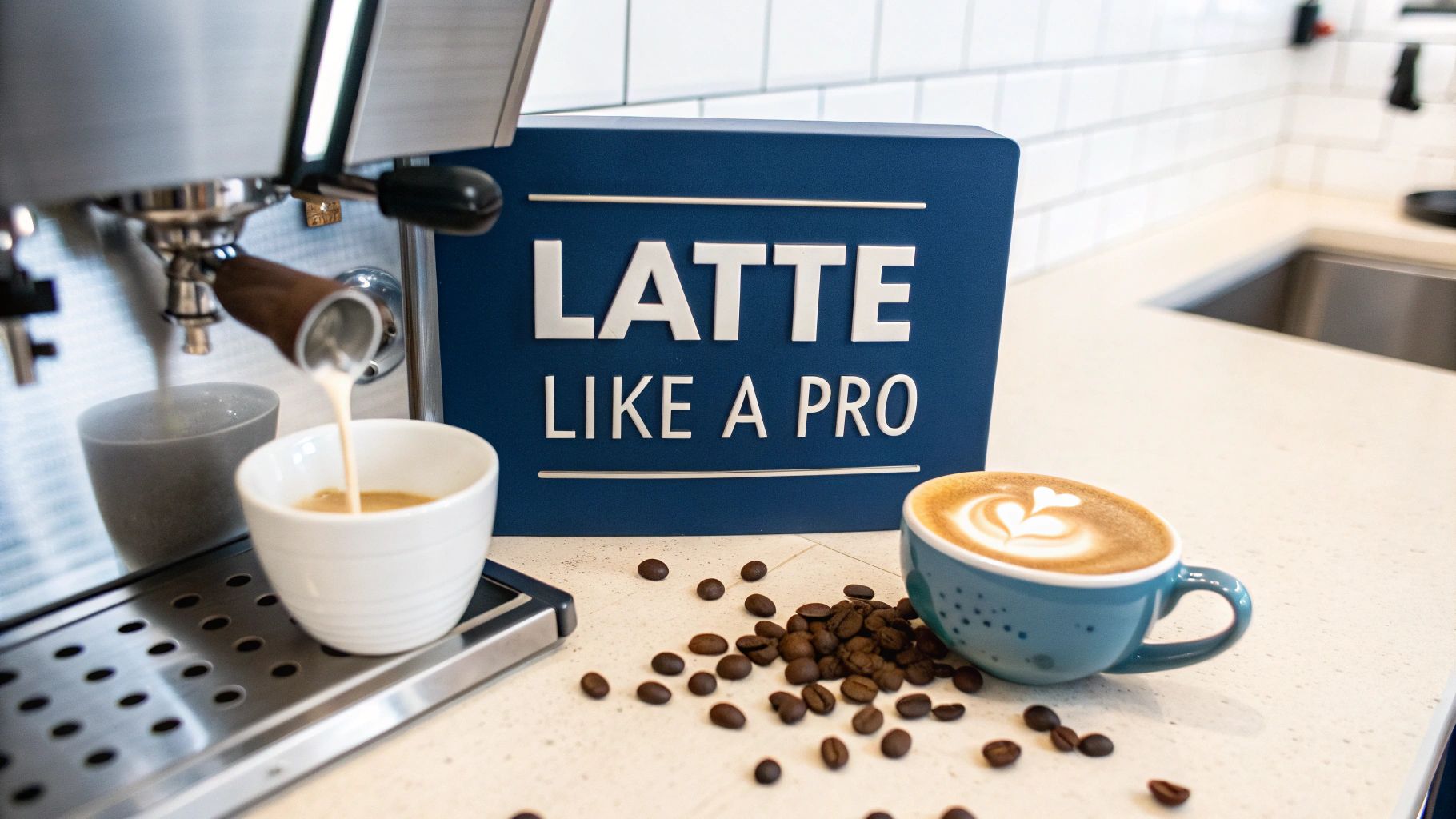
Forget the daily café queues and the dent they put in your wallet; learning how to make a latte at home is far easier than you might think. It really just comes down to two things: a rich, well-pulled shot of espresso and silky, steamed milk. When you get those right, they combine to create a perfectly balanced and creamy coffee that's hard to beat.
Your Journey to the Perfect Homemade Latte
Crafting a delicious latte in your own kitchen is an incredibly rewarding skill. This guide is built for everyone, from complete beginners just starting out to those looking to really dial in their technique. We'll walk you through everything you need to know, step by step.
Here in the UK, the coffee shop scene is absolutely booming. It's estimated that around 80% of Brits pop into a coffee shop at least once a week. But what's really interesting is that those visits only make up about 10% of all the coffee we drink. This shows a huge shift towards people becoming their own baristas at home.
A great homemade latte isn't just about saving money. It’s about turning a simple daily routine into a moment of genuine craft and enjoyment.
Our journey begins with understanding the fundamentals that make different coffee drinks unique. To get a better sense of where the latte fits into the grand scheme of things, it’s worth checking out our guide on the main https://sevensisterscoffee.co.uk/coffee-drinks-types/.
We're going to cover all the essential ground:
- Choosing the best coffee beans for a latte.
- Pulling a flawless, flavourful espresso shot.
- Achieving that velvety, perfectly textured steamed milk.
By the time we're done, you'll feel confident making café-quality coffee that will impress not just you, but anyone lucky enough to get a taste. Let's start this flavourful journey together.
Choosing Your Core Latte Ingredients
To make a latte that genuinely rivals your favourite café, it all starts with the ingredients. You can have the best machine in the world, but if your coffee and milk aren't up to scratch, you'll always fall short. The quality of these two components is the bedrock of your drink's final flavour and texture.
The journey, of course, begins with the coffee. While personal taste is everything, lattes generally need a coffee with enough backbone to cut through the milk. This is why many experienced baristas lean towards a medium-to-dark roast; it brings out those classic, comforting chocolatey and nutty notes that just work so beautifully with steamed milk.
Whether you go for a single-origin bean from a specific farm or a meticulously crafted blend, freshness is non-negotiable. Always look for the roast date on the bag and try to use the beans within a month. If you're looking for inspiration, exploring the best places to buy speciality coffee beans in the UK can introduce you to some incredible roasters who really care about quality.
Selecting The Right Milk
The milk you pick is just as crucial as the coffee. It’s not just about flavour—it's about physics. The fat and protein content directly impacts your ability to create that silky, glossy microfoam that defines a great latte.
The higher the fat content in milk, the creamier and more forgiving it will be to steam. This makes whole milk a fantastic starting point for beginners, as it produces a rich, velvety texture with a hint of natural sweetness.
To help you pick the perfect partner for your espresso, it's worth understanding how different milk types behave when steamed.
A Guide to Milk Choices for Your Latte
This table breaks down common milk types, detailing their performance under the steam wand, the foam they create, and the flavour they bring to the cup. Use it to find the best option for the latte you want to create.
| Milk Type | Steaming Performance | Foam Quality | Flavour Profile |
|---|---|---|---|
| Whole Milk | Excellent and forgiving. The high fat content makes for a stable, easy-to-work-with texture. | Rich, creamy, and velvety. Creates tight, glossy microfoam ideal for latte art. | Full-bodied and naturally sweet, complementing espresso perfectly. |
| Semi-Skimmed | Good, but less forgiving than whole milk. Requires a bit more technique to get right. | Lighter and less stable foam. Can be airy if not steamed carefully. | A cleaner, less rich taste. Lets more of the coffee's notes shine through. |
| Oat Milk | Fantastic, especially barista editions. It's the closest plant-based milk to dairy in performance. | Creamy and stable. Produces a silky microfoam that's great for pouring art. | Neutral and slightly sweet. It's a popular choice because it doesn't overpower the coffee. |
| Almond Milk | Can be tricky. Prone to splitting with heat and acidity, but barista blends help. | Often thinner with larger bubbles. Can be difficult to create lasting microfoam. | A distinct nutty flavour that can either complement or clash with the espresso. |
| Soy Milk | Steams well and holds its structure. A reliable plant-based option for texture. | Dense and stable foam, though it can sometimes be a bit stiff compared to oat. | A noticeable beany flavour profile that some people love and others don't. |
Ultimately, the right milk comes down to personal preference and what you’re aiming for in the final cup. Here’s a quick rundown of the most common choices:
- Whole Milk: This is the industry standard for a reason. Its perfect balance of fat and protein creates consistently beautiful foam and a full-bodied flavour.
- Semi-Skimmed Milk: A lighter option that can still produce decent foam, though you'll sacrifice some of the richness and creamy texture you get from whole milk.
- Plant-Based Milks: Oat milk has become a firm favourite in the coffee world, mostly thanks to its creamy texture and relatively neutral flavour. For the best results, always grab a barista edition. These are specially formulated with stabilisers that stop them from splitting and help them froth beautifully. Almond and soy are solid alternatives, too, each bringing its own unique character to the drink.
Pulling the Perfect Espresso Shot
The heart of any truly great latte is, without a doubt, a beautifully extracted shot of espresso. This isn't just about brewing strong coffee. It's a delicate dance between the grind, the dose, and the pressure, all coming together to create that rich, balanced, and flavourful base for your drink. Get this bit right, and you're already halfway to pouring a latte that rivals your favourite café.
This is especially true here in the UK, where coffee is a massive part of our daily routine. With the average person drinking around 528 cups of coffee annually, the drive to nail a perfect espresso at home has never been stronger. This reflects a deep-rooted coffee culture where mastering core skills, like pulling a great shot, is a real badge of honour. You can find out more about UK coffee consumption statistics here.
Getting the Grind and Tamp Right
Your journey to that perfect shot begins long before you even touch the brew button. It all starts with the grind. You're aiming for a consistency that feels finer than table salt but not quite as powdery as flour. If it's too coarse, water will rush through, leaving you with a weak, sour shot. Too fine, and you'll choke the machine, creating a bitter, over-extracted mess.
Once you’ve dialled in the grind, it’s time to tamp. Your goal is simple: create a perfectly flat and evenly compacted puck of coffee grounds in your portafilter. This forces the pressurised water to flow through uniformly, extracting all that lovely flavour evenly. Aim for firm, consistent pressure—about 15 kg, which feels similar to pressing a firm orange on a countertop.
A great espresso shot is a visual treat. You should see it start dark and thick, almost like warm honey, before it lightens into a gorgeous caramel colour. The whole show should take between 25 to 30 seconds.
Diagnosing Your Shot
Look, even the most seasoned baristas pull a bad shot now and then. The real skill is knowing how to figure out what went wrong and what to adjust for next time. If you're just starting out, our detailed guide on how to make espresso at home has some excellent in-depth troubleshooting tips.
Here are a few common problems and how to sort them out:
- Sour or Weak Flavour: A classic sign of under-extraction. The water shot through the coffee too quickly. Your fix? Try making the grind a touch finer or increasing your dose slightly.
- Bitter or Burnt Taste: This means you’ve got over-extraction on your hands—the water took too long to get through the coffee. Coarsen your grind a little to speed things up.
- No Crema: That beautiful reddish-brown foam on top is called crema, and it's a sign of a good shot. If it’s thin or non-existent, your beans might be a bit stale, or your grind is probably too coarse.
Mastering espresso is a craft, plain and simple. It takes practice, but the incredible flavour that awaits is well worth the effort.
Right, your espresso is pulled and looking gorgeous. Now for its perfect partner: the milk. Getting your steamed milk right is what takes a decent coffee and turns it into a truly luxurious latte. We’re not just warming it up here; the aim is to create microfoam—a silky, paint-like texture that’s completely free of those big, chunky bubbles.
It's no surprise that more people are trying to nail this at home. The demand for top-tier coffee is booming, with projections showing that UK consumers could be spending around £6.1 billion on coffee outside the home by 2025. That growing appreciation for a proper barista-made latte is inspiring coffee lovers to bring that quality into their own kitchens.
The whole process really boils down to two key phases. First, you add the air. Then, you mix it all together. Simple as that.
Mastering the Steam Wand
If you’ve got an espresso machine, the steam wand is your best friend for this job. Before you even think about putting it in the milk, give it a quick purge. Just a one-second blast to clear out any water that's been sitting in there.
Now, dip the tip just below the surface of the milk in your jug. You're listening for a gentle hiss, almost like the sound of tearing paper. That’s the sweet spot. It tells you you're introducing air and stretching the milk to build that lovely foam. You only need to do this for a few seconds, just until the outside of the jug starts to feel lukewarm.
Once you’ve got enough air in, plunge the wand deeper into the milk. This second part is all about creating a vortex, a swirling motion that folds the foam back into the milk. This is what breaks down any larger bubbles and creates that signature velvety texture. Keep an eye on the temperature; you're aiming for 60–65°C. Any hotter and the milk's proteins start to break down, which will kill the sweet flavour you're after.
This texture is precisely what makes a latte different from its cousins. A latte has a decent layer of steamed milk with a smaller cap of foam. A flat white, on the other hand, has a much thinner, more integrated layer of milk. If you're curious, you can learn more in our guide on how to make a flat white.
No Steam Wand? No Problem
Don't have an espresso machine with a steam wand? Don't sweat it. You can still whip up some pretty decent froth for your homemade latte.
- Handheld Frother: Gently heat your milk on the hob or in the microwave (but don't let it boil!). Then, pop in a battery-operated frother and whizz it until you get a texture you're happy with.
- French Press: This is a great little hack. Pour warm milk into your French press and plunge the filter up and down rapidly. Keep going until the milk has pretty much doubled in size.
While these methods won't give you true microfoam, they are fantastic alternatives and will still help you make a delicious latte right at home.
How to Pour Your Latte and Create Simple Art
Right, this is the moment it all comes together. You've pulled a perfect espresso, you've steamed your milk into a silky microfoam, and now it's time to marry the two into a beautiful, harmonious drink.
Before you even think about pouring, give that milk jug a firm swirl. This is a crucial little step. It folds the microfoam back into the milk, ensuring the texture is consistent, glossy, and free of any big, separated bubbles. What you're aiming for is a jug of milk that looks like fresh, wet paint.
Now, for the pour. Grab your cup of espresso and hold it at roughly a 45-degree angle. Tilting the cup like this gives you a much larger surface area to work with. It helps the milk slide under the crema, rather than just splashing on top and destroying that lovely layer.
The Pouring Technique
Start your pour from a few inches above the cup, aiming for the centre of the espresso. This initial "high pour" is what lets the milk dive beneath the crema and begin mixing with the coffee below. Keep the stream thin and steady.
As the cup starts to fill up, begin lowering the spout of your milk jug closer and closer to the surface of the coffee. Get it right down until it’s almost touching. You'll see the magic start to happen here – the white microfoam will begin to appear on the surface, pushing the darker crema outwards. This is the foundation for all latte art.
Don’t get hung up on perfection with your first few tries. The real goal is just to get a feel for how the milk flows and interacts with the espresso. The art is a fun bonus that comes with practice.
Creating a Simple Heart
The heart is the classic beginner's design for a reason. It's simple, satisfying, and a great way to finish your drink.
- As the cup is nearly full, keep your pour steady in the very centre. A white circle of foam will start to form and expand.
- Once that circle is about the size you want, lift the jug just a touch and pour straight through the centre of the circle, moving towards the far edge of the cup.
- This final "pull-through" motion is what drags the foam and creates that classic heart shape.
That creative final touch is what makes your homemade latte feel truly special. It's a little sign of the care and craft you've just put in, and the rewarding result of mastering the whole process from start to finish.
Common Questions About Making Lattes
Even after you've got the basic steps down, making a latte at home can throw up a few curveballs. Don't worry, it's all part of the process. Getting a handle on the most common sticking points is the quickest way to level up your technique and troubleshoot like a pro.
The Ideal Latte Ratios
One of the first things people ask is about the right balance of espresso and milk. A classic latte is typically built on one part espresso to about two or three parts steamed milk, with just a thin layer of foam on top. In practice, this usually means a 30-60ml shot of espresso mixed with around 150-240ml of milk.
But here’s the thing: that's just a starting point. Feel free to play around with it. If you're after a stronger, more punchy coffee flavour, just dial back the milk a bit and let that espresso really sing.
The beauty of making coffee at home is the freedom to experiment. Unlike an Americano, where the ratio of water to espresso is quite defined, a latte offers more flexibility to find your perfect balance. You can explore how ratios differ in our guide on how to make an Americano coffee drink.
Troubleshooting Milk Frothing
"Why isn't my milk frothing properly?" This is probably the most common frustration I hear, but the fix is usually surprisingly simple.
- Start Cold: Always, always use milk straight from the fridge. Cold milk buys you more time to get air into it before it gets too hot to handle.
- Check Your Technique: Keep the steam wand's tip just below the surface of the milk. You're listening for a gentle "paper tearing" sound. Once the milk has stretched enough (increased in volume), dip the wand deeper to create a smooth, swirling vortex.
- Milk Choice Matters: Whole milk is your best friend here. Its higher fat and protein content helps create a stable, creamy microfoam. If you're using a plant-based alternative, grab a "barista edition" for the best results.
And yes, you can absolutely make a decent latte without a fancy machine! Just brew a strong coffee concentrate using an AeroPress or a Moka pot. For the milk, warm it gently on the stove and use a cheap handheld frother to whip up a nice foam. It won't be exactly the same, but it's a fantastic alternative.
At Seven Sisters Coffee Co, we believe that exceptional coffee starts with exceptional beans. Discover our carefully sourced and expertly roasted coffee to elevate your homemade lattes. Find your perfect blend at https://sevensisterscoffee.co.uk.

